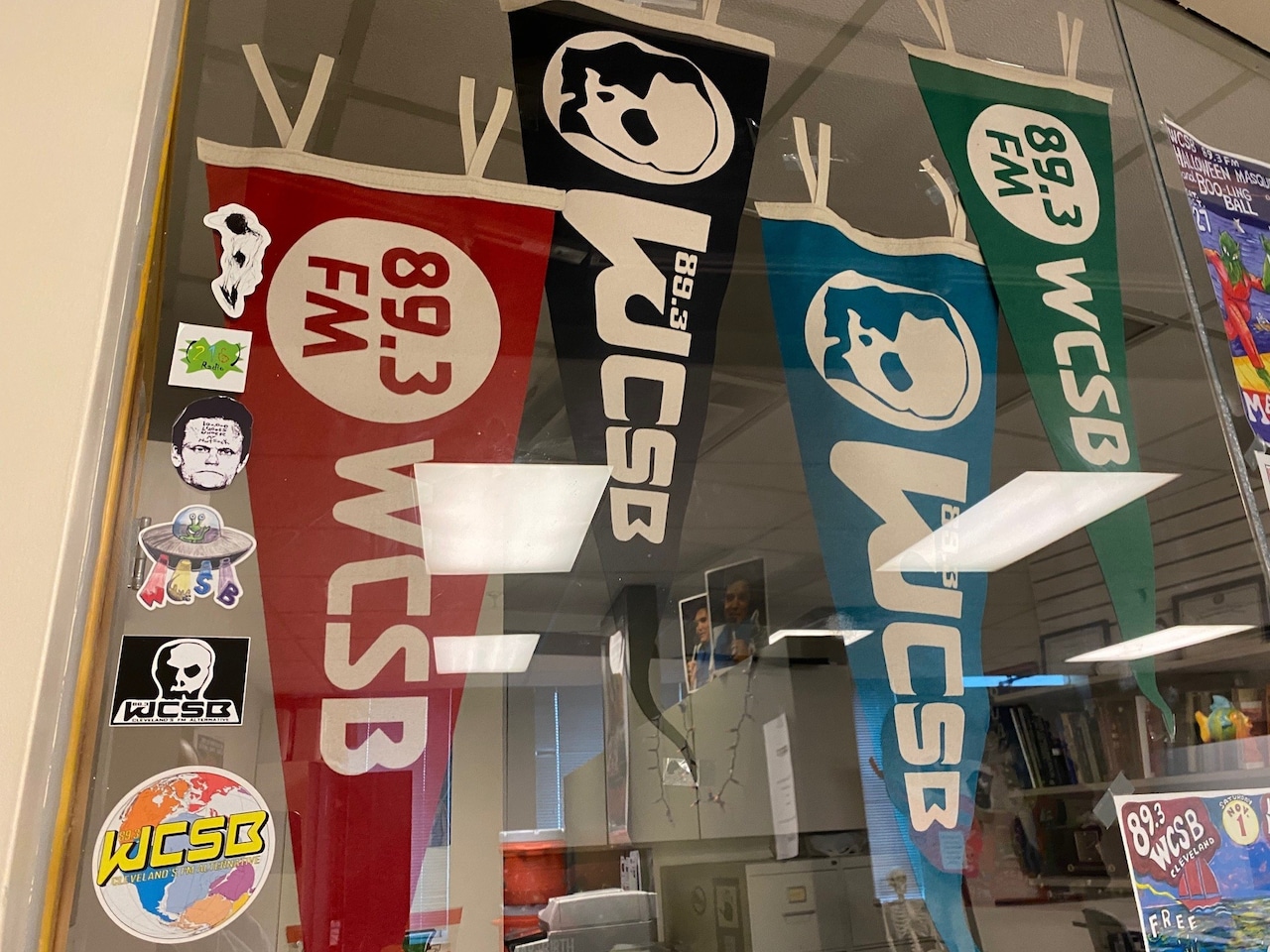CLEVELAND, Ohio— On Oct. 3, the familiar buzz of WCSB 89.3 FM at Cleveland State University gave way to the smooth jazz sounds of Ideastream Public Media’s JazzNEO.
In an instant, on national College Radio Day, nearly 50 years of student- and community-run programming—not to mention broadcast legacy—vanished from Cleveland’s airwaves.
In a hasty online meeting, university president Laura Bloomberg and Tachelle Banks, vice president of student belonging, revealed a “mutual decision” between CSU and Ideastream to the WCSB community.
There was little explanation, no warning and no time for questions.
How does one get a front-row seat for such a bombshell? Well, as a CSU alumnus and associate programmer of WCSB for almost four years — my DJ handle-anagram-alias “Pietrek Archaen” had a show Mondays 6-9 a.m. — I was actually invited to the 11:30 a.m. call where news of the station’s demise arrived.
During the meeting, the WCSB signal dropped. Before noon, students were being escorted from the building by campus police, the station’s website and stream went offline and something announced as a “service,” took its place.
An institution went dark.
A letter went out to campus explaining that CSU’s board of trustees and Ideastream’s executive board approved what Bloomberg called a “promising new partnership.”
“The station will retain its call letters, and CSU will continue to maintain the Federal Communications Commission (FCC) license for the station,” Bloomberg wrote.
Pulling the plug
For half a century, the old WCSB (now going by “XCSB” as it remains in limbo/transition) had been more than a student organization. It was a community radio hub, a beacon of Cleveland’s underground—a place where punk sat beside jazz, talk shows mingled with esoteric late-night programs and underserved found voice.
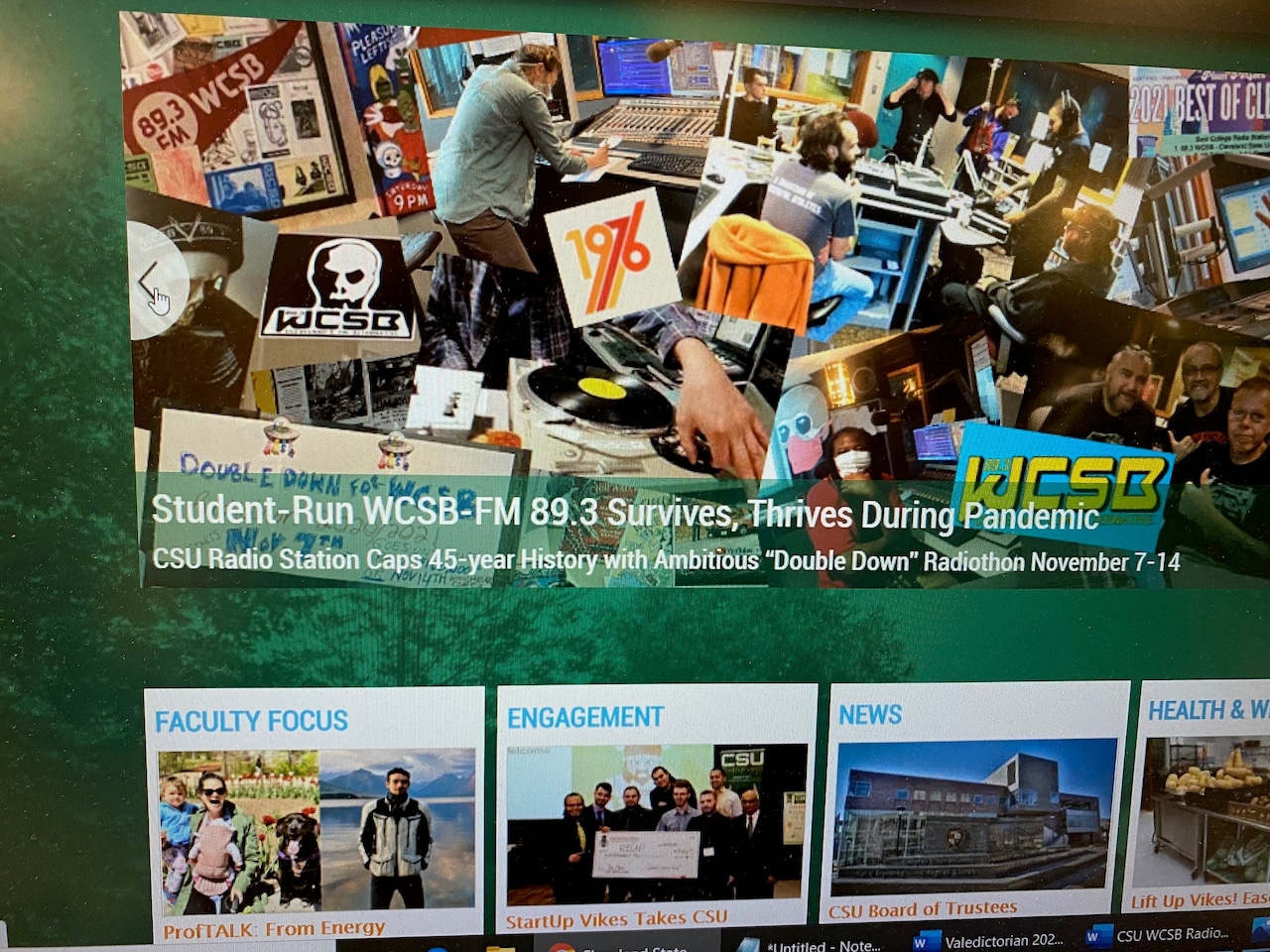 A story trumpeting WCSB’s 45-year anniversary on Cleveland State University’s homepage also appeared to be missing following the announcement.Peter Chakerian, Cleveland.com
A story trumpeting WCSB’s 45-year anniversary on Cleveland State University’s homepage also appeared to be missing following the announcement.Peter Chakerian, Cleveland.com
Programs for Polish, Hungarian, Arabic, German, Slovenian and Latin American audiences flourished. Students, artists and outsiders found a home there. And now, without warning, it was all gone.
The change came through an operating agreement between CSU and Ideastream, the regional NPR affiliate. Cleveland.com/The Plain Dealer reporter Laura Hancock delved into the “why” CSU would do this without receiving a dime. It’s a perplexing calculus.
On the surface, leadership pitched it as a “partnership” that would offer “career opportunities” for students, with few details.
Ideastream framed it as expanding the reach of its 24/7 jazz stream.
Weeks earlier, that organization received a $1 million personal gift from Char and Chuck Fowler (of the eponymous foundation) to bolster jazz initiatives.
Both institutions have been past beneficiaries of the Fowlers, who were 2020 Cleveland Arts Prize winners.
What no one seemed prepared for was the backlash.
Planned in darkness?
Supporters say the format change was handled without transparency. There was no consultation with alumni, staff, or community—just a press release, a conference call and flipped switches.
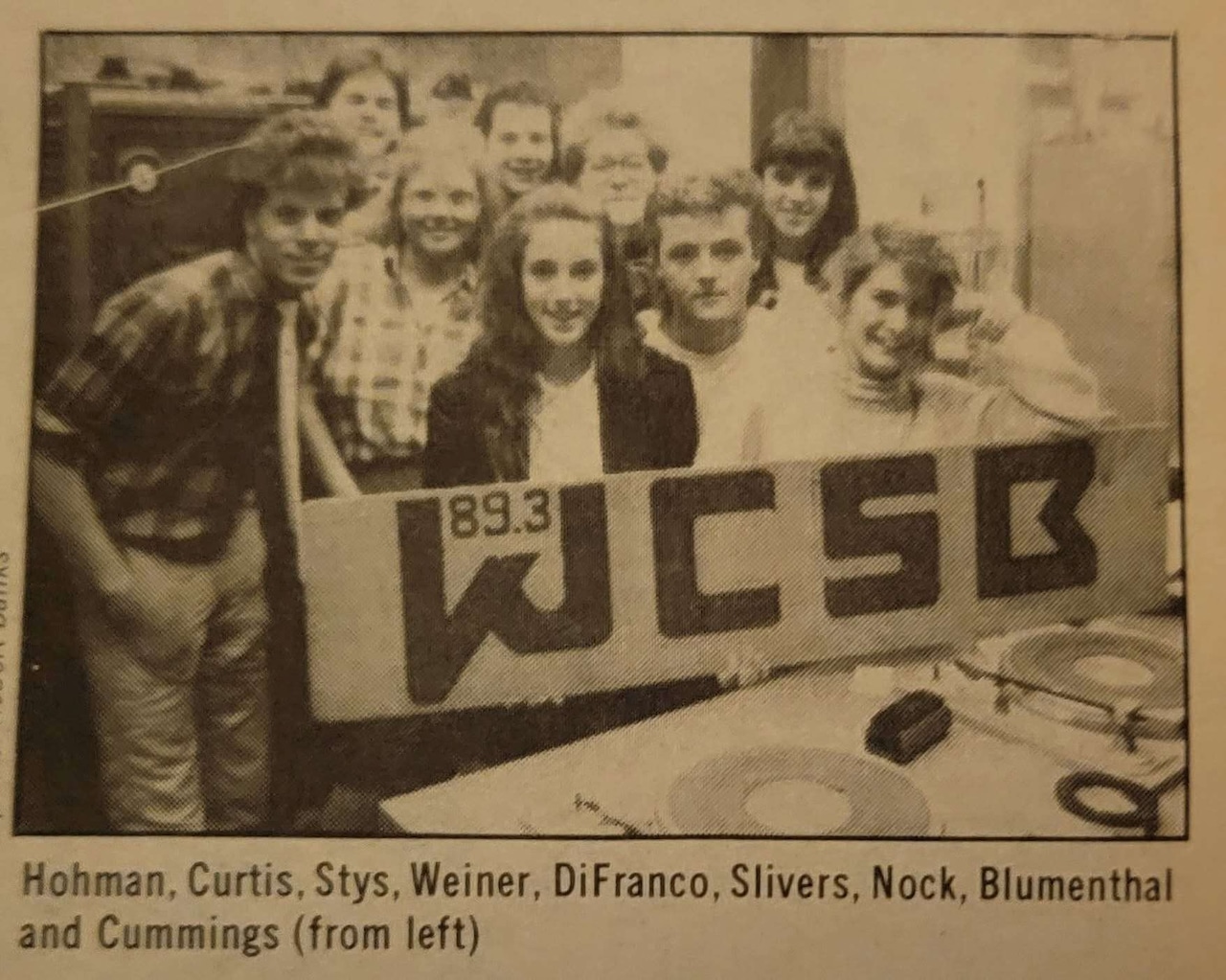 Collections of WCSB staffers and events adorn the walls and collections of ephemera at 3100 Chester Ave., which once housed Cleveland State University’s radio station. They are memories of a simpler time in the station’s now ended 49-year history.Courtesy of WCSB
Collections of WCSB staffers and events adorn the walls and collections of ephemera at 3100 Chester Ave., which once housed Cleveland State University’s radio station. They are memories of a simpler time in the station’s now ended 49-year history.Courtesy of WCSB
By the weekend, decades of sweat equity from students and volunteers had been reduced to a line item in a partnership agreement.
On Tuesday, Oct. 7, a silent protest drew 250 students, alumni and community members to CSU’s Student Center Plaza in the rain.
A week later, Bloomberg and Ideastream CEO Kevin Martin appeared on Ideastream’s “The Sound of Ideas” in an attempt to explain the move.
What followed was an excruciatingly painful game of “corporate speak bingo.”
Bloomberg and Martin stuck to said talking points—“student opportunities,” “expanded reach,” “community benefit”—but offered few specifics.
Along the way, Martin bizarrely invoked the murder of George Floyd as a catalyst for Ideastream’s intern pay system — a moment tethered to nothing in particular – and kept referring to a “study” from which the merger decision and format change was made.
No data from the study was shared during the hour.
Callers asked pointed questions. Answers were evasive, repetitive. Nobody outside CSU’s upper administration seemed to know ahead of time and nobody inside either institution could articulate why a merger was necessary.
However, FCC filings show the station in administrative transition as of Monday, Sept. 29, during a WCSB folk program—days before the deal was said to have officially gone through.
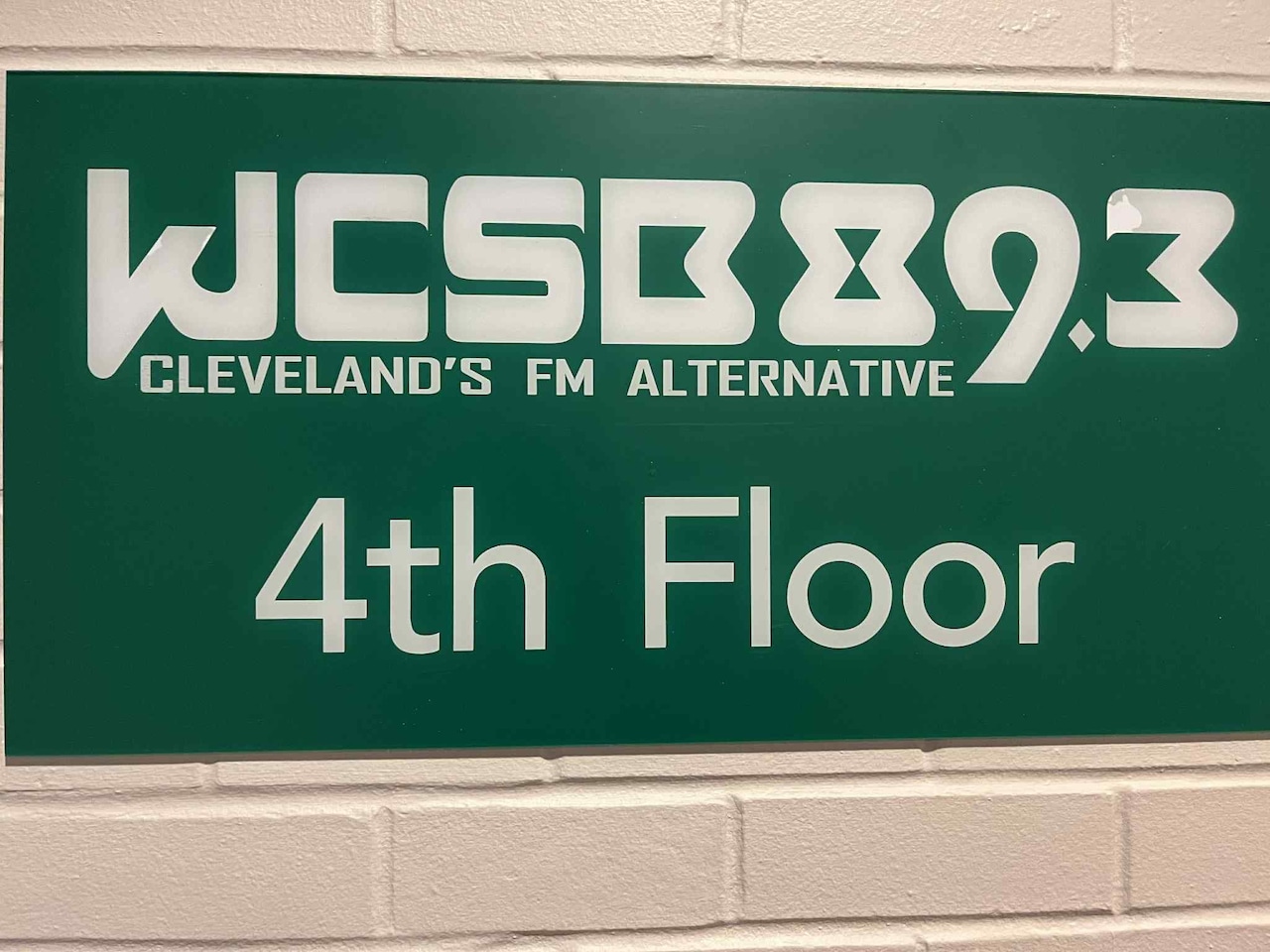 The sign welcoming station members (students, volunteers) and guests to the 4th Floor studios in the Cole Center on Chester Ave.Peter Chakerian, Cleveland.com
The sign welcoming station members (students, volunteers) and guests to the 4th Floor studios in the Cole Center on Chester Ave.Peter Chakerian, Cleveland.com
Cleveland.com has filed public records requests for communications between CSU and Ideastream.
A college is supposed to be about students. WCSB was the best experience that these students could get.
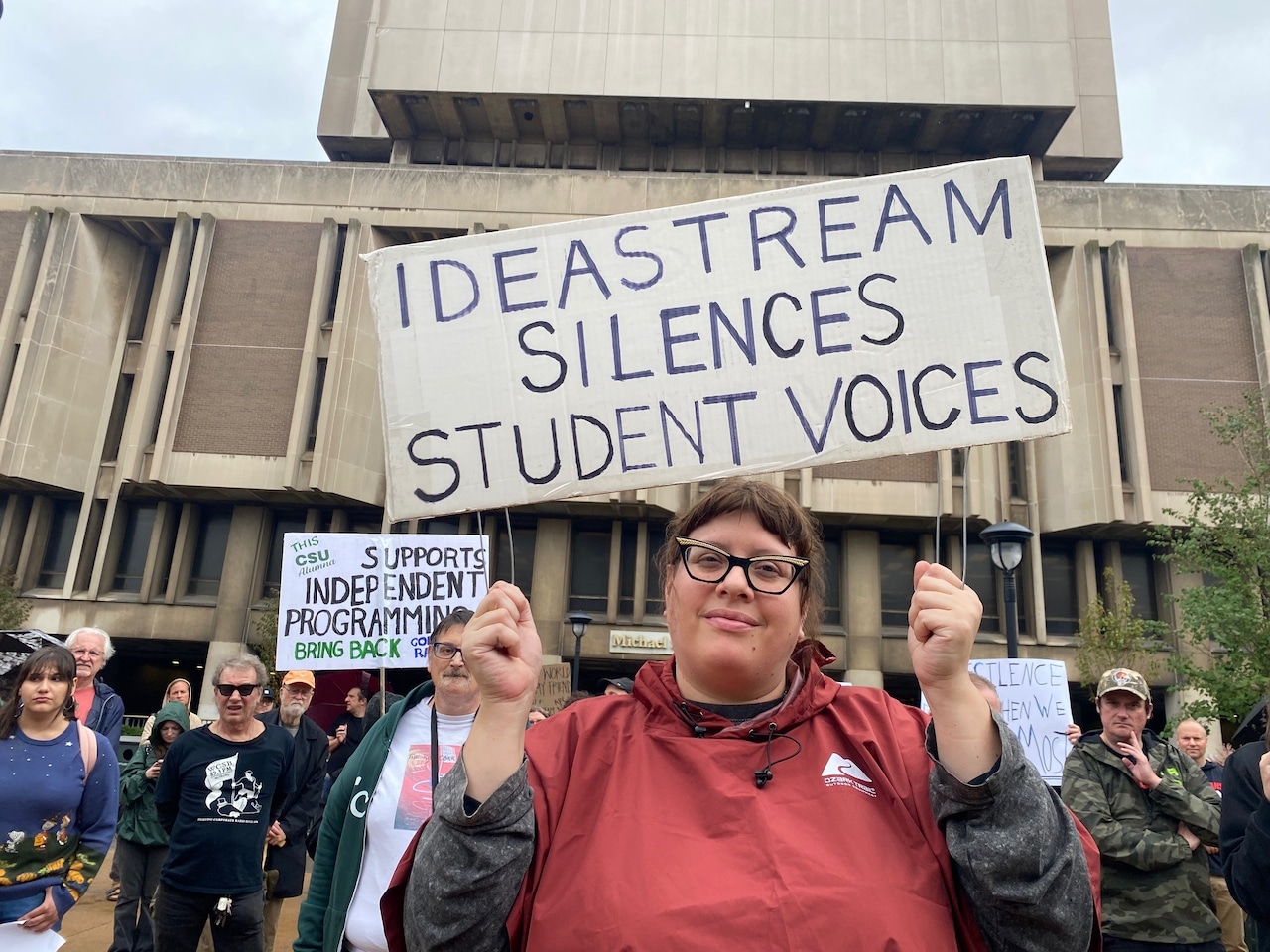 Of the 250 or so silent protesters at Cleveland State University on Tuesday, Oct. 7, many carried signs that said it all.Peter Chakerian, Cleveland.com
Of the 250 or so silent protesters at Cleveland State University on Tuesday, Oct. 7, many carried signs that said it all.Peter Chakerian, Cleveland.com
Aftermath: self-inflicted PR wounds
When Bloomberg became CSU president in 2022, she was seen as a fresh start on the heels of Harlan Sands’ abrupt departure because of “differences regarding how the university should be led in the future.”
But as CSU’s financial issues mounted, news of her finalist status for the presidency of the University of Minnesota soured the honeymoon.
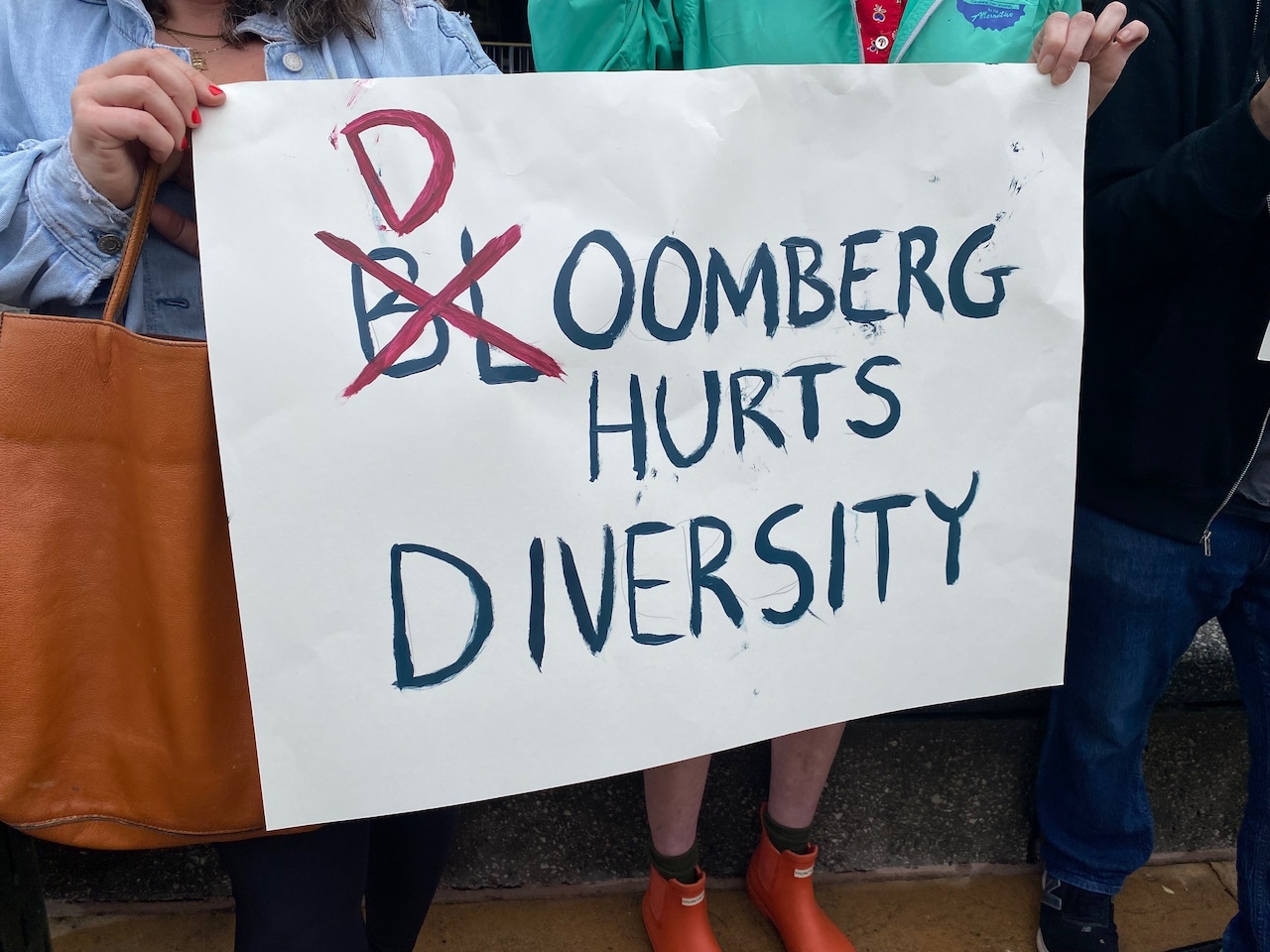 The crowd that gathered on the University Center plaza (mostly) honored the “silent” part of the protest. But the signs spoke volumes, particularly in condemning the decision and its makers.Peter Chakerian, Cleveland.com
The crowd that gathered on the University Center plaza (mostly) honored the “silent” part of the protest. But the signs spoke volumes, particularly in condemning the decision and its makers.Peter Chakerian, Cleveland.com
After Bloomberg’s announcement on Oct. 3, alumni, DJs and listeners flooded social media outlets to decried the moves.
“This is appalling,” wrote alumna and Emmy-winner Luanne Bole-Becker on Facebook.
“[Husband/longtime Cleveland media personality] Bob and I were part of the team that put WCSB on the air in 1976. To give no notice, no respect to the students, the community programming, the long history and tradition of a cherished and vital part of Cleveland is disturbing. Shame on you, both Cleveland State and Ideastream, for this shoddy behavior.”
Not an isolated incident
As shocking as it feels locally, what happened to WCSB fits a national trend: slow absorption of college radio stations by public/NPR affiliates.
CSU is the third American university in the last month-plus to remove students from their own station.
Last month, WPSU at Penn State University announced it would be closing its NPR and PBS affiliate station, citing budget pressures from inflation, declining enrollment and state funding reductions.
And Northwest Public Broadcasting at Washington State University as a licensee is downsizing, planning to cut staff and shut down its public TV station (KWSU-TV) following federal funding rescissions.
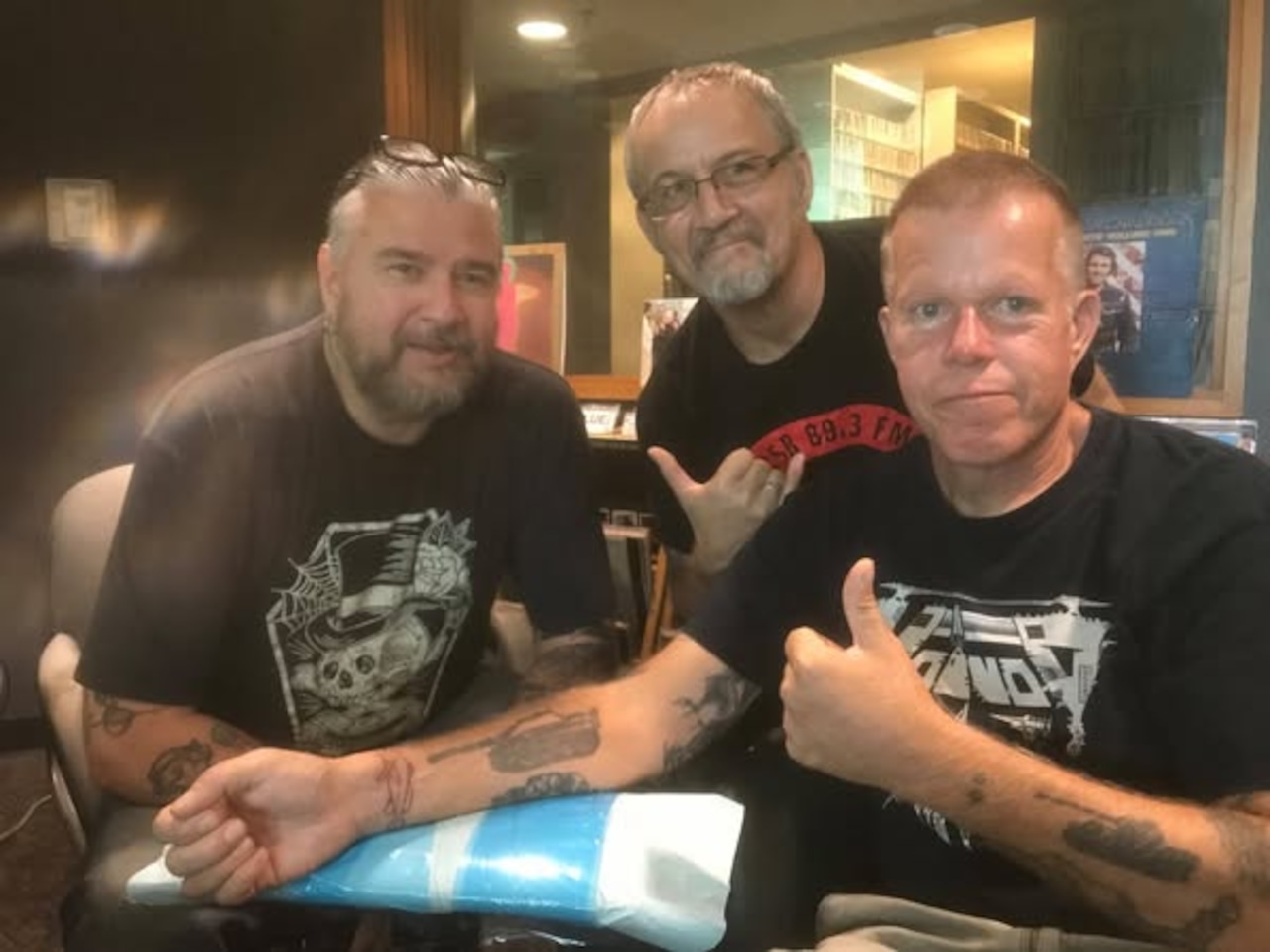 Rodney Rose, Dan Lenhart and Derek Hess (l to r) at the WCSB studios after an on-air appearance. Hess, who is a world-renowned visual artist, was a longtime host at the station.Peter Chakerian, Cleveland.com
Rodney Rose, Dan Lenhart and Derek Hess (l to r) at the WCSB studios after an on-air appearance. Hess, who is a world-renowned visual artist, was a longtime host at the station.Peter Chakerian, Cleveland.com
Since the 1990s, dozens of universities have sold or leased their FM signals, citing budget pressures or “strategic partnerships.”
WCAL (St. Olaf College) was sold to Minnesota Public Radio in 2004 despite legal protests.KUSF (University of San Francisco) was abruptly pulled off air in 2011 and sold to the Classical Public Radio Network.WRAS (Georgia State) was handed to Georgia Public Broadcasting for daytime hours in 2014, negotiated without student input.KPLU (Seattle)—an NPR jazz/news powerhouse—was nearly folded into KUOW before listeners raised $7 million to keep it independent.
Motivations are almost always financial: universities see licenses as assets; public broadcasters see expansion opportunities.
On paper, it’s strategic. In reality, it’s messy. And in most cases, it’s not at all transparent.
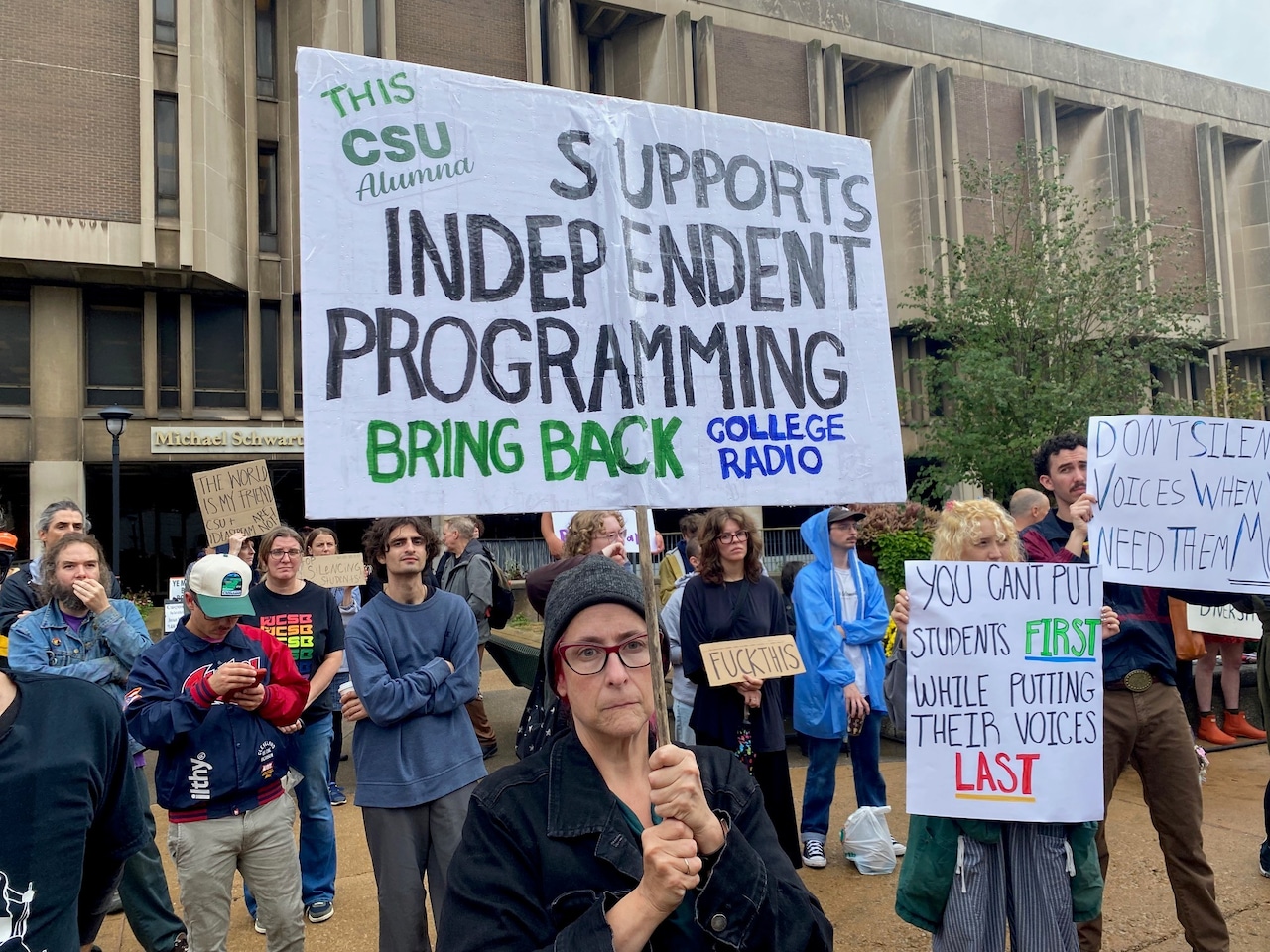 The messaging at the WCSB Silent Protest on Tuesday, Oct. 7 said the loud part quietly. Protesters emphasized that “you can’t put students first while putting their voices last.”Peter Chakerian, Cleveland.com
The messaging at the WCSB Silent Protest on Tuesday, Oct. 7 said the loud part quietly. Protesters emphasized that “you can’t put students first while putting their voices last.”Peter Chakerian, Cleveland.com
Why this matters
Officials pointed to internships at Ideastream as the “new opportunity” for students.
But opportunities for internships have been available to students at Ideastream with or without a station change for a very long time. What’s more, podcasting and internships can’t replicate the educational value of running an FCC-licensed station.
Operating a station teaches real-world compliance with federal law, EAS protocols, station IDs, engineering, community programming and live troubleshooting.
There’s no pause button in live radio. Students also learn marketing, PR, event planning, accounting and leadership. Perhaps most crucially, WCSB gave students something internships rarely do: ownership.
Any student could walk in, learn, excel and eventually lead. Interns follow instructions; station staff membership make decisions.
WCSB amplified diverse voices across the city. It was a megaphone and soapbox, not unlike Speakers’ Corner in the northeast corner of Hyde Park in London.
 Cleveland State University and Ideastream silenced student voices by abruptly seizing control of WCSB’s independent, student-run radio station — a move that columnist Leslie Kouba sees as part of a growing and troubling trend of suppressing free speech in America.Getty Images
Cleveland State University and Ideastream silenced student voices by abruptly seizing control of WCSB’s independent, student-run radio station — a move that columnist Leslie Kouba sees as part of a growing and troubling trend of suppressing free speech in America.Getty Images
Lessons from the past
If CSU and Ideastream thought this would go away quietly, they don’t understand media, history or the long memories of elephant-like Clevelanders.
In San Francisco, the sale of KUSF drew citywide condemnation. Atlanta’s WRAS deal made national headlines and tarnished GPB’s reputation. Minnesota Public Radio’s WCAL deal led to years of litigation.
And then there’s KPLU, the cautionary tale turned triumph. In 2015, Pacific Lutheran University announced plans to sell the beloved jazz/news station to KUOW.
Backlash was swift. Listeners formed “Friends of 88.5,” raised $7 million in six months and bought the station. KPLU became KNKX (“Keep News, Keep Jazz”), remaining independent. KUOW’s reputation took a major hit it, one it never fully recovered from.
Public media relies on listener trust. Alienating those listeners can lead to donor defections, negative press and lasting reputational harm—or all of the above, something CSU and Ideastream are now confronting in real-time.
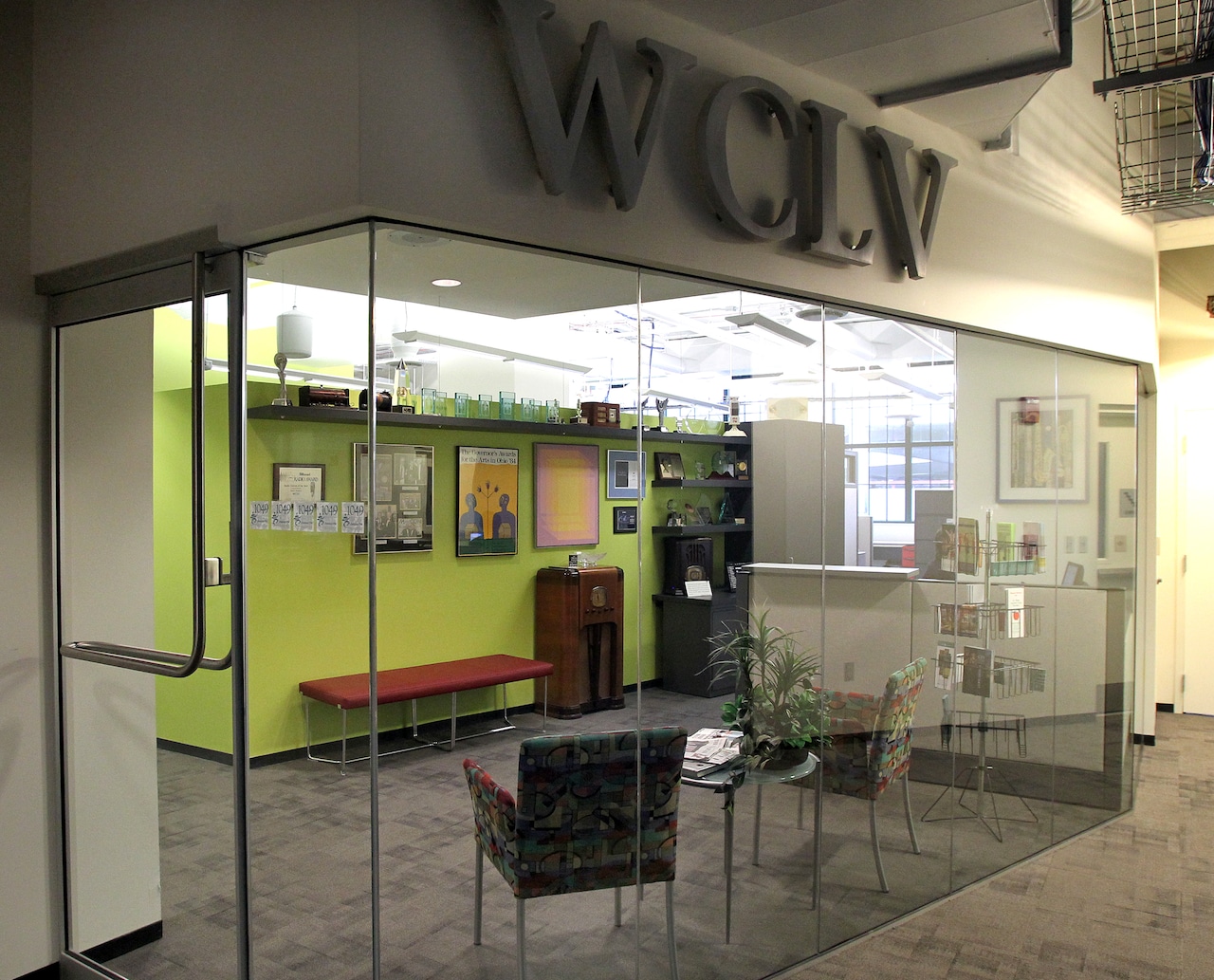 Cleveland’s classical music radio station WCLV-FM has been broadcasting from The Idea Center at Cleveland’s Playhouse Square as part of the Ideastream public radio and TV family of stations since 2010. In 2022, it will move the more powerful frequency 90.3-FM as part of the recently announced Ideastream/WKSU-FM 89.7 merger. (Chuck Crow/The Plain Dealer)
Cleveland’s classical music radio station WCLV-FM has been broadcasting from The Idea Center at Cleveland’s Playhouse Square as part of the Ideastream public radio and TV family of stations since 2010. In 2022, it will move the more powerful frequency 90.3-FM as part of the recently announced Ideastream/WKSU-FM 89.7 merger. (Chuck Crow/The Plain Dealer)
CHUCK CROW THE PLAIN DEALER WCLV/FM 104.9 moved from its Warrensville Heights studios, dubbed “Radio Ranch,” to new offices in Idea Center in PlayhouseSquare in December. The classical music station is sharing quarters with Ideastream, the umbrella organization for WCPN FM/90.3 and WVIZ Channel 25. The Plain DealerThe Plain Dealer
Déjà vu all over again
This isn’t Ideastream’s first consolidation, either. In 2021, it “merged” with WKSU, Kent State’s NPR affiliate, bringing Northeast Ohio’s two biggest public stations under one umbrella. WCLV’s classical format shifted frequencies, WKSU became the primary NPR station, but goodwill Ideastream had built began to erode.
There were layoffs, cultural rifts and backlash to lost programming.
The WCSB move is different, though—it’s not another public broadcaster, but a student station, cutting at the heart of student media, cultural diversity and local autonomy.
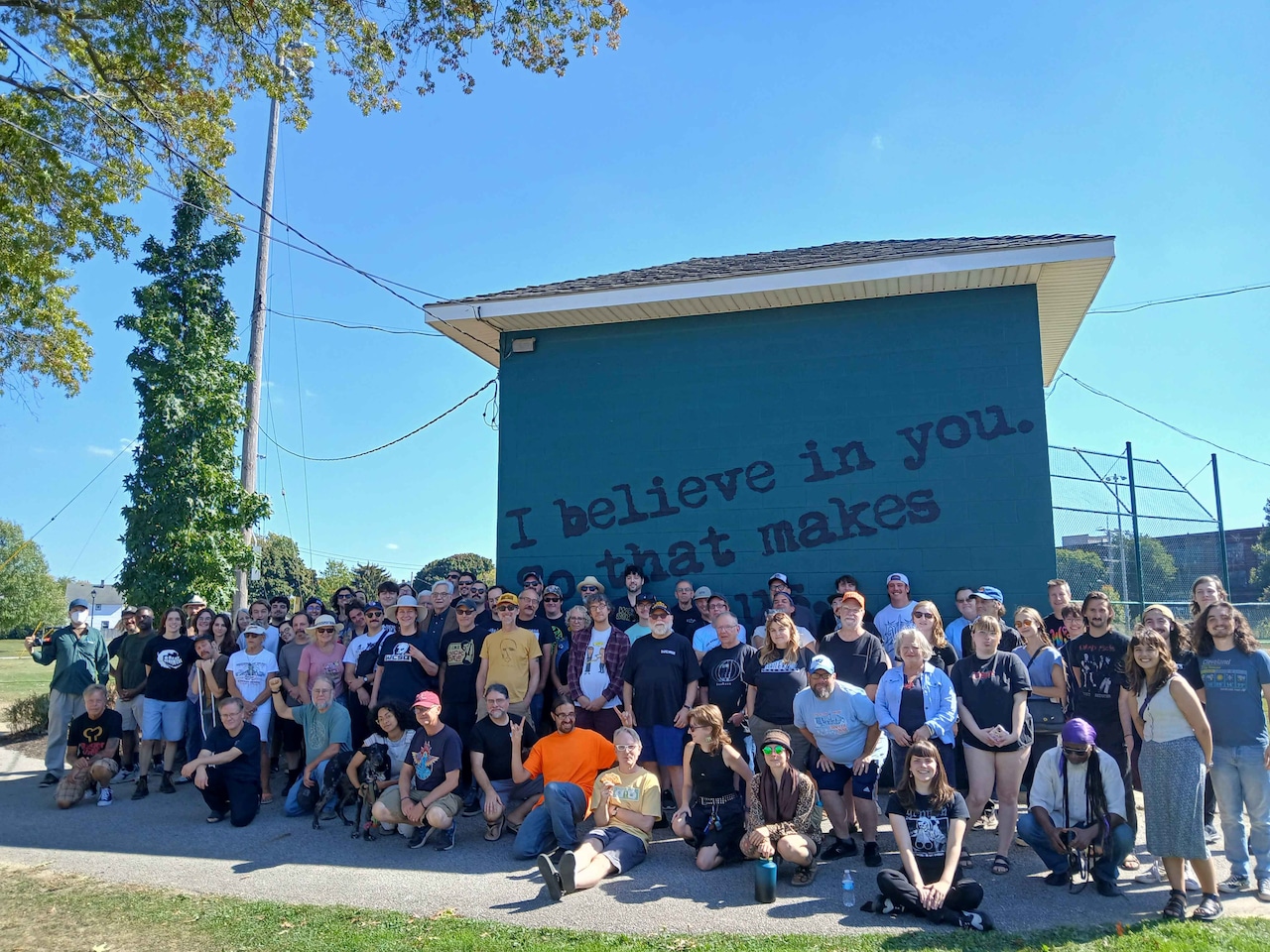 Summer 2025, Madison Park, Lakewood, Ohio: No one in this picture could have predicted that it would be the last WCSB General Staff meeting. This picture represents the lion’s share of staff members who made WCSB go.Courtesy of WCSB
Summer 2025, Madison Park, Lakewood, Ohio: No one in this picture could have predicted that it would be the last WCSB General Staff meeting. This picture represents the lion’s share of staff members who made WCSB go.Courtesy of WCSB
For now, CSU and Ideastream are holding the line.
WCSB’s FM signal belongs to Ideastream for the next eight years; CSU retains the license, which means they could choose to sell it outright afterwards.
Students have been pushed toward streaming and podcasting, but there’s a lot more at stake.
Resistance is growing. Alumni networks are mobilizing. The story is resonating nationally with anyone who’s watched a college station disappear from their dial.
History suggests two likely outcomes: another WRAS or KUSF—fait accompli and lingering bitterness—or a KPLU-style movement that forces reconsideration.
CSU leaders “want WCSB to continue as a student organization,” and they’ve suggested the station consider building its own online streaming platform—though they don’t plan to assist with that process.
The university’s Center for Campus Engagement is also undergoing major changes that affect how student groups are funded, recognized and operated. So it’s hard to tell whether or not that platitude will hold.
Ideastream has no plans to maintain the station’s longtime home at 3100 Chester Ave. CSU owns all the equipment and music library—except for items on loan, donated materials, or items belonging to CSU’s School of Music.
The EAS and transmission equipment will be transferred to Ideastream.
The university has said the space can be used to continue station operations through another medium—but they’ve also indicated CSU may not own that building (the Cole Center) within three to five years.
If the station moves off-campus, its equipment and library must stay with CSU, though officials have said they may consider a buy-back arrangement.
The former station currently has about $143,000 in its gifts and grants account.
Station members are exploring the possibility of forming an independent nonprofit and considering legal options.
I’ve been around long enough to know Clevelanders don’t let go of cultural institutions without a fight.
Cleveland is still not over Art Modell moving the Cleveland Browns in the dead of night, or Sokolowski’s University Inn closing. Anything cut from the “by the people, for the people, of the people” cloth that’s meaningful in this town is never truly abandoned.
That includes a pre-Oct. 3 WCSB 89.3FM.
Chakerian was an employee of Cleveland State University from 2021-2023.
 Cleveland State University Student Center with Rhodes Tower in the backgroundJohn Pana, cleveland.com
Cleveland State University Student Center with Rhodes Tower in the backgroundJohn Pana, cleveland.com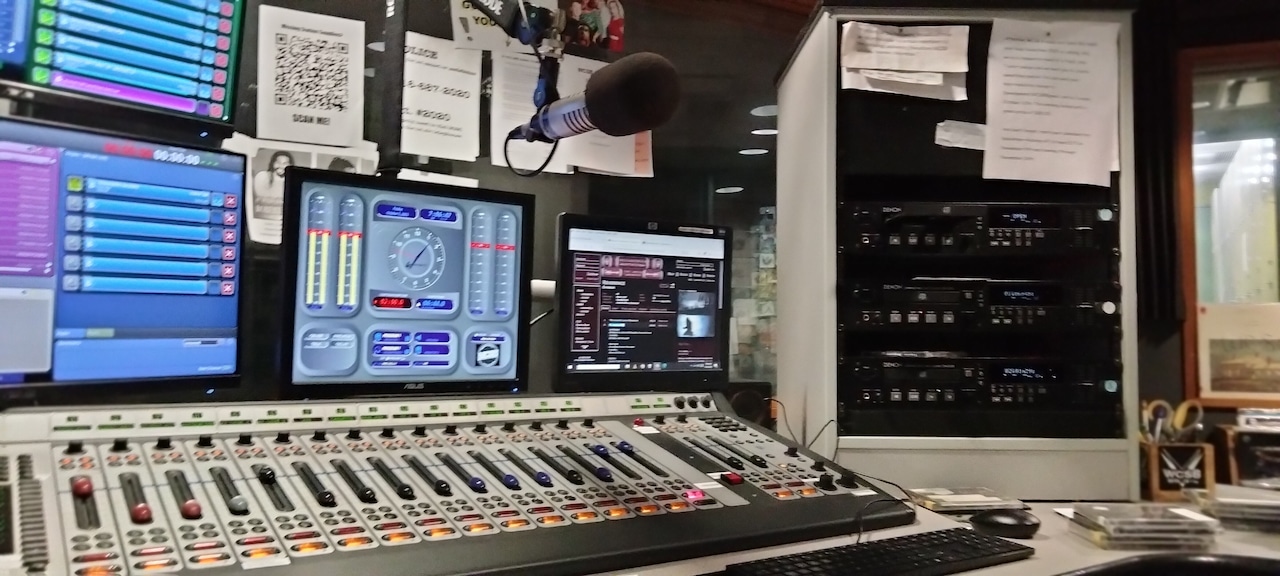 WCSB 89.3FM Cleveland.Peter Chakerian, Cleveland.com
WCSB 89.3FM Cleveland.Peter Chakerian, Cleveland.com
If you purchase a product or register for an account through a link on our site, we may receive compensation. By using this site, you consent to our User Agreement and agree that your clicks, interactions, and personal information may be collected, recorded, and/or stored by us and social media and other third-party partners in accordance with our Privacy Policy.

